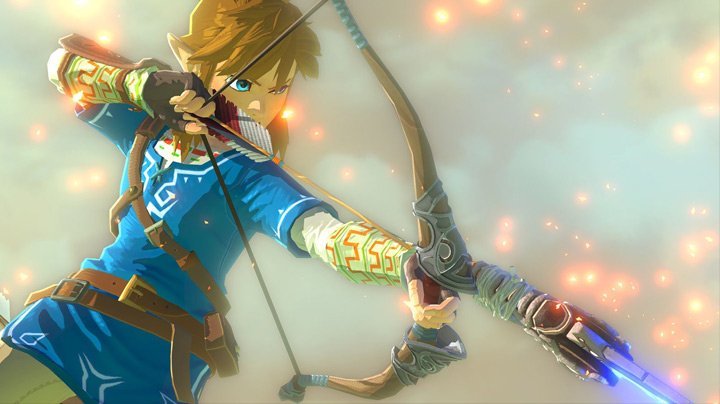Speaking at GDC, Nintendo’s Takuhiro Dohta revealed how the ‘multiplicative gameplay’ of The Legend of Zelda: Breath of the Wild was created.
This is the second in our three-part report on the Breath of the Wild session from GDC 2017. The 90 minute talk was an extremely in-depth examination of the many decisions the development team made in creating Link’s latest adventure, so we’ll be breaking our coverage into three to ensure we cover as much of the detail as possible.
Physics and Chemistry in the Wild
Takuhiro Dohta, technical director on The Legend of Zelda: Breath of the Wild, joined Nintendo in 2003 and has worked on a number of past Zelda games including Twilight Princess, Skyward Sword and The Wind Waker, as well as the likes of Wii Sports and NintendoLand.
In developing Breath of the Wild, Dohta and his team had to work with the convention breaking, multiplicative gameplay approach that had been devised by the game’s director, Hidemaro Fujibayashi.
“From the terrain system to construct the massive world, to things like graphics and sounds, level design methodology, AI, animation, even our pipeline for managing asset creations and tasks, we were forced to rethink our approach to tech-related challenges,” says Dohta.
The answer to overcoming these challenges was found in the disciplines of physics and chemistry, with a few lies thrown in for good measure.
“I consider the Zelda games to be actions games,” says Dohta. “To go about our business of breaking conventions, we decided to take a step back and think about the most primitive elements of action games.”
Dohta outlined how most action games are made up of the same components: collision, movement, and object states. Taken together, collisions and movement are what’s generally termed in video games as ‘physics’.
“When it comes to game development you don’t want the sort of physics you find in a text-book,” he explains, “but a kind that fits the need of the game you’re making. This is what we call ‘game physics’.”
“Game physics could also be called false physics or liars physics, but why would you need to tell lies? This is something we do to improve control and responsiveness. In other words, to fulfil the demands of the game design.”
 Source: giphy.com
Source: giphy.com
Dohta says that players will believe in a game’s particular set of rules as long as they are consistent, and importantly, clever.
“One of the joys of being a programmer is deciding just how to go about telling our clever lies, and how to best express the things that happen in an imaginary world.”
Given that Breath of the Wild would feature a large and varied open world Dohta knew that the game would need a robust physics system to bring it to life. It was also important that it would allow the player a high degree of freedom to experiment.
“For example,” says Dohta, “having the freedom to carry any object you like to any location in the game. If you try hard enough you can roll a rock from the beginning of the game to the place you fight the final boss.”
To support the development of Breath of the Wild, a decision was made to use the Havoc engine to help create the game’s complex physics simulation.
“The stability and robustness of the engine, not to mention its proven track record in the games industry, made Havoc an easy choice. This would enable us to tell all the clever lies we wanted,” says Dohta.
Examples of the final physics model in use can be found in the game’s stasis and magnesis abilities, as well as in the wide array of physical objects found in the game world.
“In our various experiments there was one thing that we noticed: if you unify your game world with a set of consistent physics rules, the player will come up with ideas all sorts of things they want to try,” Dohta says.
The result is a world where simple elements can create complex results.

Chemistry engines
The Zelda series has long made use of chemistry elements for many of its puzzles, but the term ‘chemistry engine’ is not as ubiquitous as physics engines when it comes to game design.
“Creating puzzles with solutions that reference the way the real world works can help players solve them instinctively,” says Dohta. “And so, we decided to develop a chemistry engine.”
If a physics engine can be described a rule-based movement calculator, a chemistry engine would be a rule-based state calculator, he explains.
In the engine things that don’t hold a constant state – like fire, water and ice – are elements. Solids objects, like trees, rocks, and even the player, are considered materials. The chemistry engine uses these things to make calculations based on three simple rules:
- Elements can change the state of materials – for example, leaves on tree can burn and disappear.
- Elements are able to change each other’s states – for example, fire disappears when in comes into contact with water
- Materials cannot influence each other’s states
“The model is an extremely simple one but allows for the expression of all sorts of events,” says Dohta. “Aside from rigid body dynamics we consider all phenomena that occur in nature to be chemistry”
This mean that electricity and wind are also considered elements which is why, in one example, Link can propel himself forward on a raft by using a leaf to create gusts of wind.
“Given the the right situation elements can also generate energy and impact the physical world. In this way all the constituent parts of the world we created are governed by our rule of physics and chemistry.”
The outcome is a game in which almost every object and element is linked together in a consistent way, with the addition of some clever lies to help make the interactions more enjoyable to experience.
“It was our aim to create an active and more open-ended play experience, and we hope players will enjoy coming up with their own unique solutions to the game’s puzzles and challenges.” concludes Dohta.
Part one of our Breath of the Wild GDC report was on the multiplicative gameplay; part three, from art director Satoru Takizawa, is on the game’s stunning art style.






